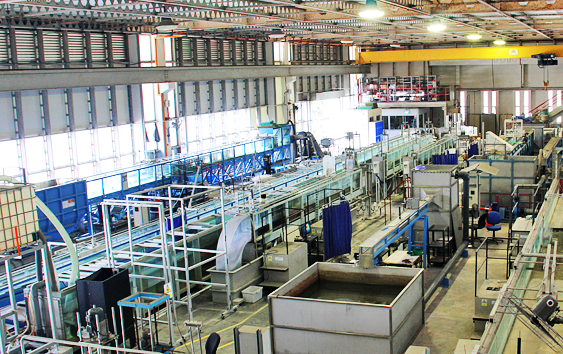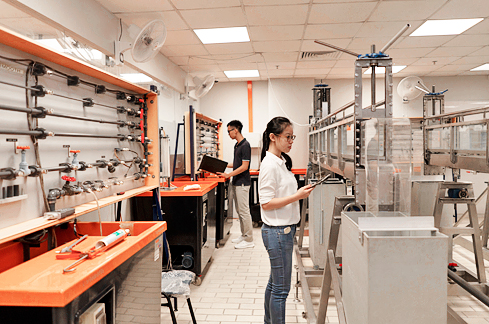About The Lab

The Hydraulics Laboratory specialized in the study of fluid mechanics. It consists of the Hydraulics Modelling Laboratory at N1-B5-W301 and the Hydraulics Studio at N1-B3b-28 and they are supported and maintained by 3 full-time technical staff.
The Hydraulics Modelling Laboratory – It has a floor area of 1430 m² with a 7m headroom. It has a 1.5m wide by 3m deep underground trench that runs along the inside laboratory in a rectangle (45m x 15m).
The trench can store up to 450 m³ of water and is capable of supplying and receiving water from testing apparatus/flumes. The laboratory houses major equipment such as PIV, rainfall apparatus, data loggers, recorders, pumps and other sophisticated electronic equipment.
It has many tanks and flumes ranging from 5 meters to 48 meters which are used for teaching (CV2711 & EN2712), final year projects (CV4911 & EN4911), URECA and research undertaken by undergraduates, postgraduates, researchers and academic staff.

The main facilities are as follows:
- A Wave Flume coupled with an advanced random wave generator for coastal wave transformation studies, size 35m (L) x 0.55m (W) x 0.6m (D).
- A Wave Flume powered by hydraulics, capable of generating irregular waves with active absorption for coastal research and engineering projects, size 48m (L) x 1.55m (W) x 1.55m (D)
- A tilting re-circulating Sediment Transport Flume, size 30m (L) x 0.6m (W) x 0.6m (D) for open-channel flow studies.
- 2 units of re-circulating fume, size 14m (L) x 0.6m (W) x 1.2m (D) & 30m (L) x 0.7m (W) x 0.6m (D) respectively for open-channel flow studies.
- 4 units of tilting re-circulating Flume, size 8m (L) x 0.6 (W) x 0.6m (D) for open-channel flow studies.
- A 20m 2-Stage Flume, size 20m (L) x 1.6m (W) x 0.6m/0.75m (D) for open-channel flow studies.
- 3 tilting re-circulating flumes, size 12m (L) x 0.3m (W) x 0.45 (D), 11m (L) x 0.6m (W) x 0.7m (D) & 9m (L) x 0.3m (W) x 0.2m (D) respectively for open-channel flow and pipe flow studies.
- A tilting re-circulating enclosed flume, size 5m (L) x 0.2 (W) x 0.15 (D) for open-channel flow and pipe flow studies.
- Various other small tanks and flumes.
The laboratory has three special rooms for laser imaging operation. A laser imaging system coupled with fast speed cameras for digital particle image velocimetry and planar laser induced fluorescence is carried out by final year students and researchers conducting studies and research in the area of environmental hydraulics.
The Hydraulics Studio – The Studio has a floor area of 160 m² Studio and serves primarily as a teaching room for the second year course (CV2711, EN2711 and EN2712). It houses some computers and teaching apparatus to support undergraduate teaching and final year student projects. The Studio is also used to conduct courses for full-time post-doctoral research fellows and MEng and PhD students.

The following equipment are housed in the Studio:
- Hydrostatic properties of fluid apparatus: To determine the hydrostatic thrust acting on a plane surface immersed in water and to determine the position of the line of action of the thrust and to compare the position determined experimentally and the determined theoretically.
- Discharge measurement apparatus: To understand the concept of the energy principle for water flowing through an orifice and to determine the head-discharge relationship for an orifice.
- Impact of jet apparatus: To understand the concept of momentum equation and its application to determine the force exerted by a jet impinging on a solid surface.
- Friction losses along pipes apparatus: (i) To understand the concept of frictional loss along a pipe. (ii) To compare the head loss predicted using a pipe friction equation with measurements. (iii) To determine the relationship between the friction factor and Reynolds number for flows through smooth and rough pipes.
- 3m teaching flumes: The hydraulic jump phenomenon – To understand the concept of momentum equation in the analysis of the hydraulic jump phenomenon, and the mechanism of the use of hydraulic jumps to dissipate energy in open channel flows.














/enri-thumbnails/careeropportunities1f0caf1c-a12d-479c-be7c-3c04e085c617.tmb-mega-menu.jpg?Culture=en&sfvrsn=d7261e3b_1)

/cradle-thumbnails/research-capabilities1516d0ba63aa44f0b4ee77a8c05263b2.tmb-mega-menu.jpg?Culture=en&sfvrsn=1bc94f8_1)

7e6fdc03-9018-4d08-9a98-8a21acbc37ba.tmb-mega-menu.jpg?Culture=en&sfvrsn=7deaf618_1)
